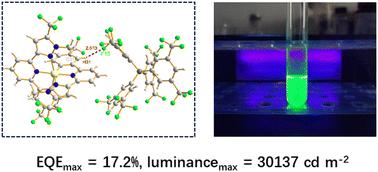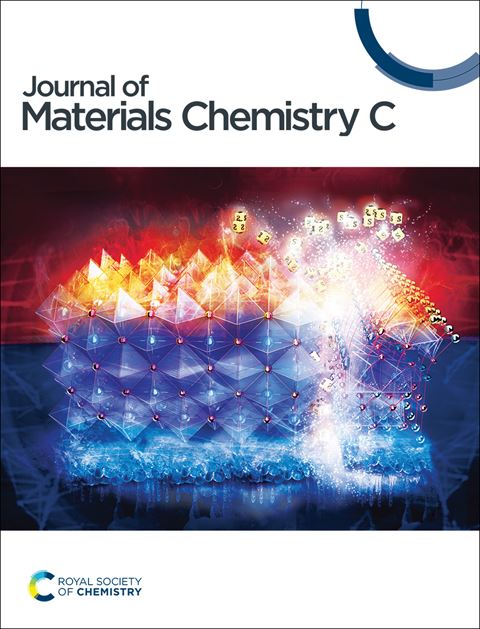High-efficiency organic light-emitting diodes based on cationic iridium(III) complexes with double tridentate ligands
IF 5.7
2区 材料科学
Q2 MATERIALS SCIENCE, MULTIDISCIPLINARY
引用次数: 0
Abstract
In order to improve the device performance of ionic Ir(III) complexes, multi dentate ligands were used to enhance the rigidity and stability of ionic Ir(III) complexes. Therefore, five cationic Ir(III) complexes with tridentate ligands were prepared. The decomposition temperatures (5% weight loss) of these complexes are between 290 and 441 °C. In polymethyl methacrylate films, these complexes show emission peaks between 488 and 537 nm with quantum efficiencies of 0.28–0.47. The density functional theory calculations indicate that the electron donating substituents on the cyclometalated benzene rings will reduce the proportion of Ir atoms in the frontier orbitals of these bis-tridentate Ir(III) complexes, thereby reducing their luminescence efficiency. Record-high device performance has been achieved with a superior external quantum efficiency over 17%, maximum brightness over 30 000 cd m−2, and quite small efficiency roll-off. The device efficiencies of complexes with triptycene groups only slowly decrease until 6000 cd cm2. These results demonstrate the great potential of ionic bis-tridentate Ir(III) complexes in state-of-the-art optoelectronic device applications.

基于双三叉配体阳离子铱(III)配合物的高效有机发光二极管
为了改善离子态 Ir(III)配合物的器件性能,使用多齿配体来增强离子态 Ir(III)配合物的刚性和稳定性。因此,制备了五种具有三叉配体的阳离子 Ir(III) 复合物。这些配合物的分解温度(5% 失重)介于 290 ℃ 和 441 ℃ 之间。在聚甲基丙烯酸甲酯薄膜中,这些配合物在 488 纳米和 537 纳米之间显示出发射峰,量子效率为 0.28-0.47。密度泛函理论计算表明,环甲基化苯环上的电子捐赠取代基会降低这些双三叉戟Ir(III)配合物前沿轨道中Ir原子的比例,从而降低其发光效率。这些复合物的外部量子效率超过 17%,最大亮度超过 30 000 cd m-2,而且效率衰减非常小。带有三庚烯基团的复合物的器件效率在 6000 cd cm2 之前只会缓慢下降。这些结果表明,离子双三叉戟Ir(III)配合物在最先进的光电器件应用中具有巨大的潜力。
本文章由计算机程序翻译,如有差异,请以英文原文为准。
求助全文
约1分钟内获得全文
求助全文
来源期刊

Journal of Materials Chemistry C
MATERIALS SCIENCE, MULTIDISCIPLINARY-PHYSICS, APPLIED
CiteScore
10.80
自引率
6.20%
发文量
1468
期刊介绍:
The Journal of Materials Chemistry is divided into three distinct sections, A, B, and C, each catering to specific applications of the materials under study:
Journal of Materials Chemistry A focuses primarily on materials intended for applications in energy and sustainability.
Journal of Materials Chemistry B specializes in materials designed for applications in biology and medicine.
Journal of Materials Chemistry C is dedicated to materials suitable for applications in optical, magnetic, and electronic devices.
Example topic areas within the scope of Journal of Materials Chemistry C are listed below. This list is neither exhaustive nor exclusive.
Bioelectronics
Conductors
Detectors
Dielectrics
Displays
Ferroelectrics
Lasers
LEDs
Lighting
Liquid crystals
Memory
Metamaterials
Multiferroics
Photonics
Photovoltaics
Semiconductors
Sensors
Single molecule conductors
Spintronics
Superconductors
Thermoelectrics
Topological insulators
Transistors
 求助内容:
求助内容: 应助结果提醒方式:
应助结果提醒方式:


